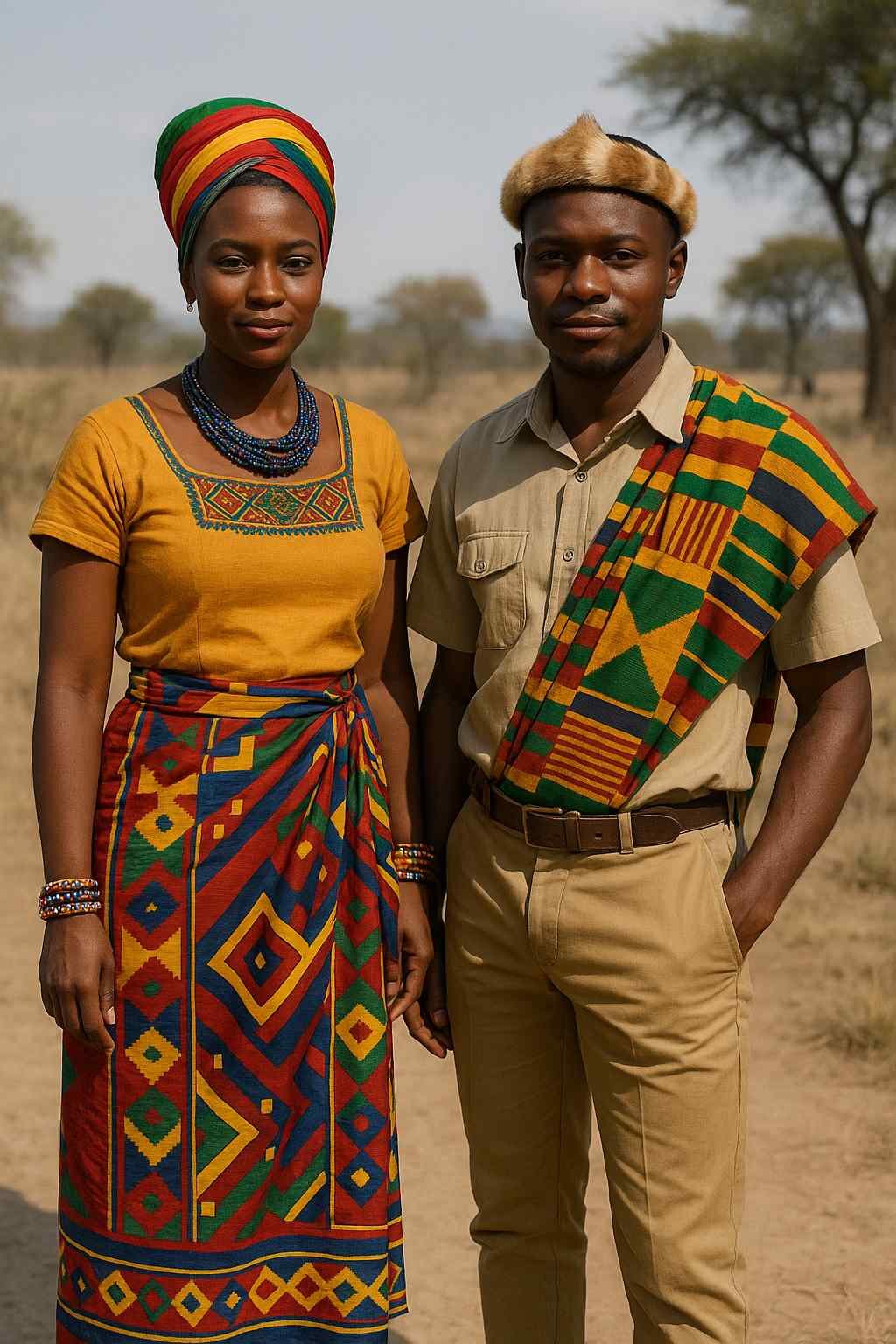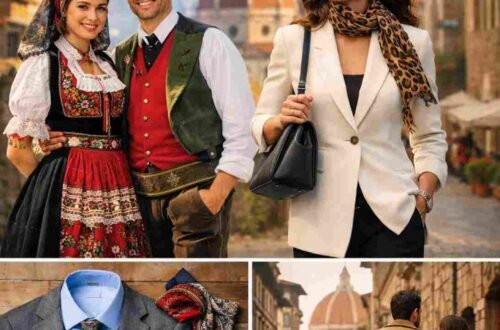Zimbabwe is a beautiful country with warm weather, friendly people, and many different cultures. What you wear here depends on the weather, where you go, and what you plan to do. This guide will help you understand traditional clothing, modern styles, and what to pack if you visit Zimbabwe.
1. Traditional Clothing in Zimbabwe
Zimbabwe has many ethnic groups, such as the Shona and Ndebele people. Each group has its own style of clothing that shows culture and identity.
Common Features:
-
Clothes were once made from animal skins or handmade cloth.
-
People wore beaded jewelry, headdresses, and wrap-around skirts or cloths.
-
Today, most people wear these only for special events like weddings, dances, and festivals.
| Group | Traditional Outfit | Extra Details |
|---|---|---|
| Shona | Animal-skin skirts or wraps called nhembe | Men also used small leather capes. |
| Ndebele | Colorful beads, rings on neck and arms, decorated skirts | Women wear beaded aprons and necklaces. |
| General | Bright head wraps, beads, and woven fabrics | Used for ceremonies or celebrations. |
2. Modern Clothing in Zimbabwe
Most Zimbabweans wear modern clothes just like in other parts of the world. However, what people wear can depend on where they live.
| Place | Common Clothing | Notes |
|---|---|---|
| Cities (Harare, Bulawayo) | Jeans, shirts, dresses, skirts | Western-style fashion is common. |
| Rural areas | Modest, simple clothes | People cover shoulders and knees. |
| Churches or religious events | Long dresses, shirts, and trousers | Dressing respectfully is very important. |
Tips:
-
People in cities dress like anywhere else — neat and casual.
-
In small towns or villages, it’s polite to dress modestly.
-
Many women wear colorful head scarves (dhuku) and wrap skirts called zambia.
Read also: Complete Guide to Albanian Clothing
3. Weather and Seasons
Zimbabwe’s weather changes during the year, so clothes should match the season.
| Season | Months | What to Wear |
|---|---|---|
| Dry Season (Winter) | May – August | Days are warm, nights are cold. Bring light jacket or fleece. |
| Rainy Season (Summer) | November – March | Hot and humid. Light cotton clothes are best. |
| Between Seasons | April & September–October | Weather can change fast. Pack layers. |
4. What to Wear on Safari
If you go on safari or into nature, choose clothes that are comfortable, simple, and safe.
Clothing Tips:
✅ Do wear:
-
Light cotton or linen clothes
-
Long-sleeved shirts and trousers
-
Earth colors: khaki, beige, olive green, brown
-
A wide hat, sunglasses, and sunscreen
❌ Avoid wearing:
-
Bright white or neon colors (they scare animals)
-
Blue or black (they attract tsetse flies)
-
Camouflage or military-style clothing (it’s illegal for civilians in Zimbabwe)
Safari Packing List:
| Item | Purpose |
|---|---|
| Long pants and shirts | Sun and insect protection |
| Hat & sunglasses | Shade from strong sun |
| Comfortable shoes | Walking and game drives |
| Light jacket | Cool mornings or evenings |
| Sunscreen & insect spray | Health and comfort |
| Small backpack | Carry water, snacks, and camera |
5. What to Wear in Towns and Cities
In towns like Harare or Victoria Falls, you can wear brighter or more stylish clothes.
-
Men: shirts, jeans, or trousers.
-
Women: dresses, skirts, or jeans with blouses.
-
Avoid very short shorts or crop tops, especially in smaller towns.
-
For evenings at lodges or restaurants, “smart casual” (clean, neat clothes) is perfect.
6. Fabrics and Colors
Best Fabrics:
-
Cotton – cool and light
-
Linen – good for hot weather
-
Quick-dry materials – good for travel and safaris
Colors to Choose:
| Situation | Best Colors | Avoid |
|---|---|---|
| Safari | Beige, khaki, olive, brown | Blue, black, white |
| City | Any soft or bright color | Very flashy colors in rural areas |
| Cultural event | Red, yellow, green, decorated fabric | Plain dark tones |
7. Packing Tips for Visitors
Here’s a simple list of what to bring for a one-week trip:
Clothes
-
2–3 T-shirts
-
2 long-sleeve shirts
-
1–2 pairs of trousers
-
1 pair of shorts (for towns)
-
1 skirt or dress
-
1 warm layer (fleece or jacket)
-
Underwear and socks
-
Comfortable shoes + sandals
-
Hat and sunglasses
Other Items
-
Sunscreen & insect repellent
-
Power bank & adapter
-
Small backpack
-
Swimwear (for lodges or falls)
-
Laundry bag (many hotels offer laundry)
8. Etiquette and Respect
Clothing shows respect in Zimbabwe. Dressing well helps make a good impression.
Do:
-
Dress modestly in villages and at religious places.
-
Take off hats indoors or in church.
-
Ask before taking photos of people in traditional clothing.
-
Keep clothes clean and tidy even if casual.
Don’t:
-
Wear clothes with offensive symbols or words.
-
Show too much skin in rural or church settings.
-
Wear camouflage — it’s against the law.
9. Shopping and Local Fashion
Zimbabwe has many markets and shops where you can buy handmade clothes and fabrics.
Popular local items include:
-
Wrap skirts (zambia)
-
Beaded jewelry
-
Head wraps (dhuku)
-
Handwoven shirts or dresses
Supporting local designers helps the community and gives you a unique souvenir.
10. Modern Fashion in Zimbabwe
Today, many young designers in Harare and Bulawayo mix traditional African prints with modern fashion. Some clothing lines reuse local fabrics to make new, trendy outfits. You can find these in markets, boutiques, or fashion shows across the country. This modern mix of old and new shows how Zimbabwe keeps its culture alive while moving forward.
11. Frequently Asked Questions (FAQs)
Can I wear shorts in Zimbabwe?
Yes, in cities and tourist spots. In rural or religious areas, wear longer clothes.
Is camouflage clothing allowed?
No. It is illegal for civilians to wear military-style clothes.
What kind of shoes should I bring?
Comfortable walking shoes for safari and sandals for lodges.
When is traditional clothing worn?
During weddings, cultural festivals, and ceremonies.
Can I buy clothes in Zimbabwe?
Yes! Local markets sell beautiful handmade clothes and accessories.
12. Final Tips
-
Dress for comfort and respect.
-
Keep colors neutral in nature, bright in towns.
-
Pack light — laundry services are available.
-
Support local artists by buying handmade items.
-
Always remember: Camouflage is not allowed.
13. Conclusion
Clothing in Zimbabwe is more than just fashion — it shows culture, respect, and connection to the land. Traditional outfits tell stories of history and identity. Modern clothes show creativity and comfort. When you visit, pack smart, dress modestly, and enjoy the beauty of Zimbabwe’s people and culture. By wearing the right clothes, you will feel comfortable, safe, and respectful — and truly experience the spirit of Zimbabwe.





